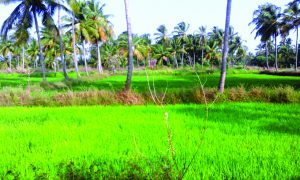
Hawkers shouting, ‘Pazham Pori, Pazham Pori (plantain fritters, Paruppa Wadai-Paruppu Wadai (lentil vadas), Chai-Chai,’ in a sing-song tone was music to our ears, confirming that we had reached our favourite holiday destination – Palghat in Kerala.
Lush green trees, pristine ponds and hours spent playing with cousins are all unforgettable memories of my summer holidays. This May, my maternal family will be congregating to celebrate the wedding of one of our younger cousins, which has set me off on a nostalgic path because summer holidays, when I was young, were only about going to my hometown.
Unlike the present generation, jetting off to exotic places, we really had no choice, and perhaps knew no other place. Come March and my parents would book train tickets to our ancestral village – Nochur. I, particularly, looked forward to meeting my grandfather – who always welcomed me with a lot of love and affection. The sight of our tile-roofed house with the post box hanging on one of the wooden pillars of the veranda made me feel that we had truly come home.
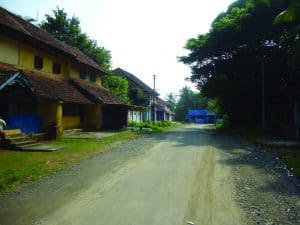
Palghat was never really a destination in any traveller’s map, though nowadays with some sharp marketing of the state as God’s Own Country, people do land up here for some ayurvedic and spa retreats. But for us children growing up in the big cities of Bombay and Delhi, our annual vacation gave us everything any discerning modern traveller would look for and more – connecting with nature, spiritual rejuvenation, gastromania, and spa retreats along with lots of familial love and pampering.
So come May, we would embark on this long train journey spanning over two nights. Our train would always reach Palghat Junction in the morning, between 7 and 8 am and what never ceased to fascinate me was the drastic change in topography between Tamil Nadu and Kerala. Coimbatore is the last station in Tamil Nadu, and as the train weaves into Kerala, one would not only notice the Western Ghats but also the greenery. I would always stand at the door of the train and be wonderstruck at how within a span of a few metres the dry barren terrain would change into lush green foliage, as if someone had stuck a different piece of land. The air too felt a little cooler.
While our fellow Malayali passengers always preferred to buy their breakfast at Palghat rather than Coimbatore, we would only be restless to reach home. Our village was just half-an-hour away from the station and as we entered it, we would be greeted by smiles and waves of its residents. “Children have arrived from the city,” they would say in the famous Palakkad dialect.
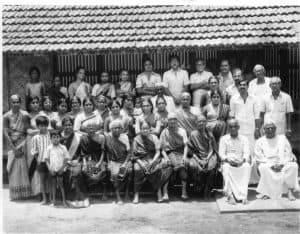
My grand-uncle has chronicled the village and our family in a series of books titled ‘Nochur Under Soft Light’, where he has described it as a ‘village with a difference.’ As you leave the bustling main road that is situated on the old seventh milestone between the townships of Kodvayur and Tattamangalam, the muddy country road “cuts through green lush vegetation flanked by palm, mango and neem trees and sprinkled with marigold”.
The village, he wrote, came into being in the 18th century when the Carnatic wars resulted in repression and political instability. Families that lived in Tanjore’s paddy-growing districts came in search of similar environs and settled in Nochur. This was one of the 64 such settlements. It derived its name from the herbal plant, ‘nochi’ that grew in abundance there. From being known as Nochi Agraharam (Brahmin settlements in South India) to Nochiyur and finally Nochur, this had become our family’s base.
The village is L-shaped with broad, clean roads and traditional attached houses. Most of the neighbours on one fork of the road were related to us. My grandfather belonged to a big family comprising six sons. The first house was where my great grandmother, Akkapatti, – a woman ahead of her times – lived. Like a true matriarch, she protected the welfare of the women farmhands, even taking up the cudgels against young misbehaving upper caste men. As relatives occupied most of the homes in this row, we children would freely walk into each other’s house, eating and drinking without any formality.

Summer is also the time when fruits such as mango, jackfruit and banana were in abundance. Since many of us would have congregated during school vacation, we would plan long sessions in the various village ponds, splashing away in the cool waters. There were about five ponds, but the pristine water of Thamara Kolum (Lotus Pond) was most inviting. The tank had an area of nearly six acres and its sandy nature kept the water pure, placid and crystal clear.
Evenings were spent near the temples, located close to another pond. My grandfather and some of the older men would sit on stone benches near the pond narrating stories or quizzing us. Their funny anecdotes and riddles never failed to entertain us. We children also enjoyed chatting under the gigantic peepal tree near the temple, making up scary ghost stories to frighten each other. Another aspect about our temple that fascinated me was that this is the only goddess (its presiding deity is an incarnation of Durga) who has an annual chariot (Ratham) festival. Perhaps her feistiness has rubbed off on most women from our village!
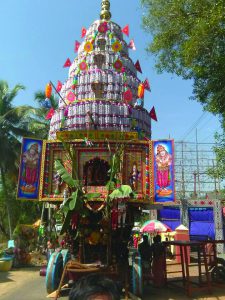
So while most of our holidays were spent in the village, we would plan picnics and short trips to places around Palghat. Catching the latest Malayalam or Tamil movie in the thatched-roof theatre was an outing we all looked forward to. Our large group consisting of aunts, uncles and cousins would walk across the field to the tin-top cinema. The highlight of this viewing was eating roasted peanuts and sipping lemon soda out of goti (marble) bottles.
On other occasions, we would visit Kalpathy village, located near the main town area to visit relatives. This has now been designated as a heritage village, in order to preserve the old structures of homes. A trip to the town would also involve a walk around Palakkad Fort and Kota Maidanam. The fort is also known as Tipu’s Fort as his father, Haider Ali, took control of this strategically important place in the mid-1700s. Today the garden in the fort and large moat is a good spot to spend your evenings.
Our family also loved going on picnic to Malampuzha Dam, Kerala’s largest reservoir. Built on the river of the same name, it holds beautiful parks and gardens. We would spend an entire day exploring these places. Inspired by the Rock Garden in Chandigarh, a similar one was inaugurated in 1996 near this dam. Designed by Nek Chand, the garden had waste like broken crockery, electrical fittings, glass bangles, bathroom tiles, wash basins and bicycle frames used to make mosaic sculptures of men, women, animals and gods. Gigantic mountains in the backdrop of the park add to the beauty of the park.
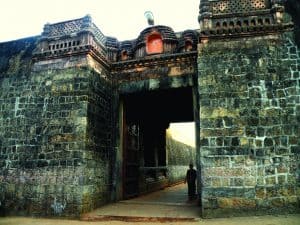
Once in a while, we would take a longer trip to the Nelliyampathy Hills, about two hours from Palghat. The landscape is beautiful with gorgeous hills and waterfalls. Legend has it that Rama and Sita rested in the dense forest here. There are many hotels and resorts in this place from where one can visit the tea plantations in its vicinity.
Thus our summer holidays would pass in a jiffy. When the rains started to lash the earth and the paddy fields around our village would start sprouting green shoots, it would be time for us to pack our suitcases. On this return trip, we would be carrying back many cartons containing tamarind, coconuts, banana chips, pickles and a whole lot of dried food products that would last us the entire year.
As we bade goodbye to our grandparents at Palghat Junction, with a promise to return next year, the train would slowly pull out of the station with the voices of the hawkers growing fainter and fainter. Only to be taken over by the din of the big cities!











